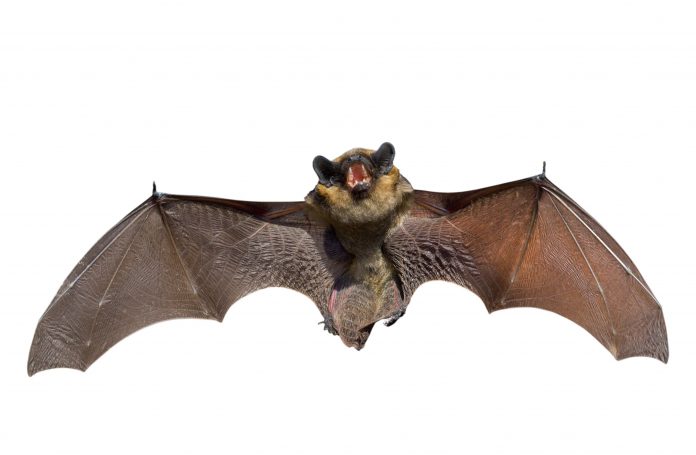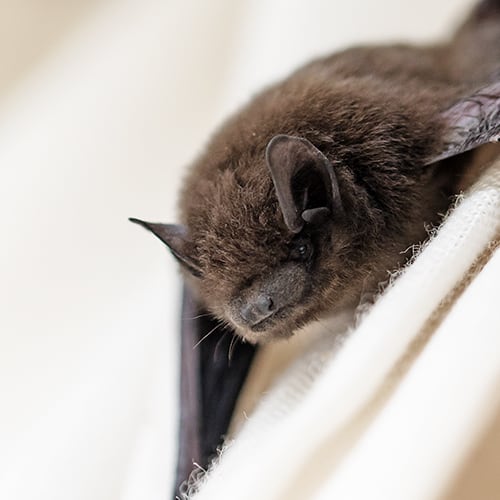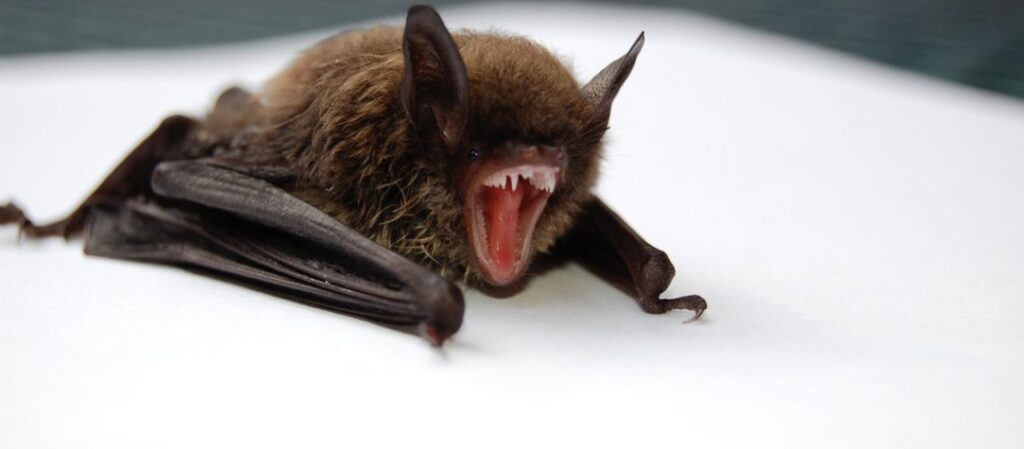How to get rid of bats
Firstly and most importantly, bats and their roosts are protected by law so you should never try to remove a bat from your home yourself. Bats spend most of the winter hibernating until they wake in April time looking for food in the evenings. Bats are most active from April to October. By September and October, bats will have mated and will start to build up fat reserves for hibernation in December.
Bats are important to our world because some plant species rely on bats to pollinate their flowers. Bats are insect eaters so they also make good pest controllers.
Finding a grounded or lost bat is a unique experience. For many people, it will be the first time they come close to one of these fascinating and unappreciated creatures. And knowing you’ve helped a bat survive is a feeling like no other!
unfortunately don’t have the resources to run a bat rescue service – but don’t worry. You can help the bat by following a few simple steps, and the National Bat Helpline may be able to point you toward experienced independent volunteers in your area who can take over from there. If not, you can take the bat to your nearest veterinary practice, and we will advise and support them.
Does the bat need help?
A bat needs help, and should not be left or released without advice, if:
It’s on the ground or floor
It’s exposed during the day (e.g., on an external wall)
It’s in the living area of a dwelling, or the public area of another building
It’s been in contact with a cat
It’s a pup without its mother (see below)
It’s stuck to something (like flypaper, barbed wire or a fishing hook)
Its roosting place has been disturbed – for example, by removing wood from a woodpile, taking a sign from a wall, or building work. If a bat has been found during building work, there are some additional things you’ll need to do to ensure that the roost is retained and the law is not broken.

How to Get Rid of Bats
As scary as they may appear, bats are actually quite benign and even shy. Though they may qualify as nuisance pests, knowing their behavior will help you to keep your home environment free of bats while letting them play their pest control role within the food chain.
Physical Characteristics
All bats have the same general shape and webbed wing structure.
The larger bats (“megabats”) may carry a wingspan of up to five feet and a weight of slightly more than two pounds. The smaller type (called “microbats”) may have a wingspan of about six inches and weigh less than one ounce.
A bat’s flight is more sporadic and swooping than a bird’s movements.
The face may resemble that of a Chihuahua.
Some bats live together in colonies typically ranging from 100-1,000 individuals. Others are solitary and live alone.
Roughly 40-50 bat species call the U.S. home, and more than 1,200 species have been discovered worldwide.
Life Cycle
There is a balance between a female bat’s slow reproductive rate (one to two babies, called pups, each year) and a bat’s fairly long life (up to 20 years). Yet because females produce few young, and because of predators like hawks, owls, and even snakes, their populations are prone to thinning numbers or extinction.
Mating season occurs during fall, with males and females meeting to breed in hibernation sites. After the pups are born during springtime, groups come together to form maternal colonies. The mothers leave at night to find food and water and return later to nurse. The pups fly away after one month, usually in the summer. Because the young are unaccustomed to flying and to the area in general, they’re the ones most likely to stray into a human residence by accident.
Understanding a Bat’s Behavior
If you are frightened by bats, know that many other people feel the same. Yet when you understand a few of their behaviors, you’ll realize why they’re generally harmless to humans

How To Get Rid Of Bats: The Complete Guide
Most people don’t like bats and would rather keep them away. Bats are found in most places. This means that bats may live on your property, be found in your attic, or hang out under your porch eaves. If you want to keep bats away, your approach will vary, depending on where the bats are congregating. This article will cover these main points.
How To Get Bats Out Of My Attic
In addition to the steps mentioned in this article, there are specific steps that you can take to eliminate bats from your house. Often bats will live in an attic for a long time before they are discovered. This means that simple decoy and other devices are not usually effective. The attic has already become much too appealing to the bat colony.
Locate All Entrance Points To Your House
Be aware that bats can enter an area in a space as small as a quarter. ⅜ of an inch is all it takes for a bat to crawl in. They love long narrow spaces because it offers them great protection. They also love to enter vía small entryways because predators can’t follow them.
That often means that the most obvious entrances are not the ones that bats use the most. It also means that the entrances that bats use may be difficult to locate. To find where bats are going in and out, watch your house. You will need to have enough people located around the perimeter to watch the entire house.
Set Up A Bat House Near The Main Entrance-Exit Point
The purpose of a bat house is to provide an alternative and safe place for the bats to roost. Bats are incredibly helpful to the local ecology and they keep insect populations greatly reduced. But, because of human encroachment into the wild, bats have become increasingly endangered. They are protected in most areas.

Bat Crazy!: Guide To Bat Removal From Attics
As a responsible homeowner, it seems as though your to-do list is never going to end. There’s always another repair or maintenance job for you to consider. After all, consider the following statistic regarding homeowners throughout the United States. It indicates that, on average, homeowners spend around one to four percent of the home’s overall value on improvement projects. In other words, you’re not alone in needing to care for your home every now and then.
Perhaps, though, you have a peskier problem. You might be looking for strategies for bat removal from attic spaces. You’ve noticed some flying, furry housemates you need to relocate. If that’s the case, you’re in luck. The good news is, you’ve come to the right place with this article.
Peek Your Head in the Attic to Confirm You Have a Bat Problem
Imagine you’re sitting in comfort on your couch after a long day at work. Out of nowhere, you hear something overhead bustling around. The thing is, your home only has one story! So, you assume an animal has made its home in your attic. Don’t jump to conclusions as to what kind of animal is sharing your house, though.
Consider Investing in Repellents
Perhaps your bat infestation is rather small compared to others. Only one or two have visited your attic in the wee hours of the morning. If that’s the case, you still want to act upon getting the situation under control. Unhandled, the bats can start to grow a real family right under your roof. To avoid an increase in the problem, remove any bats from your attic as soon as you notice them.
Hang Some Aluminum Foil and Mirrors in Your Attic
Perhaps you don’t want to rely on chemicals or foods to expel bats from your attic. Well, there’s another option to consider. It’s a common and incorrect myth to assume that all bats are blind. On the contrary, bats can see quite well. Rather, they rely more on hearing their high-pitched navigational noises.

How to get rid of Bats
What is the best way to get rid of bats? You have two options: repelling bats from your house and mounting an alternative house for them in the yard. The former is a short-term solution while the latter will allow you to solve your bat problem for a long time.
Electronic deterrents repel bats with light, sound, or airflow and are more efficient against bats.
Having bat infestation in the attic sounds terrible to many homeowners. Upon hearing these words, particularly when it comes to a large colony established by these animals, one would wish just to give up everything and start looking for a new home. The reason for that is that numerous myths have grown up around bats, making people fear these flying creatures, instead of learning how to get rid of bats properly.
The biggest myth about bats is that they are vampires feeding on human blood. In most cases it is not true. Yes, there is a particular sub-species, which specifically prefers blood (what is meant here is animal blood, not human one). This species is dangerous and can carry diseases, but you’ll have to try hard to encounter them and should attack them first to get bitten for sure. The vast majority of bats that inhabit human accommodations feed on insects (mosquitoes, flies, etc.), or, less frequently, on small animals such as frogs.
Therefore, these pests are not exactly pests. They can be “tamed” and you can build special bat shelters for them (refer to our separate article covering the best bat houses). But still, there are species that feed on fruit causing damage to horticulture. It would therefore be preferable to keep these creatures away. These are covered in the following review.